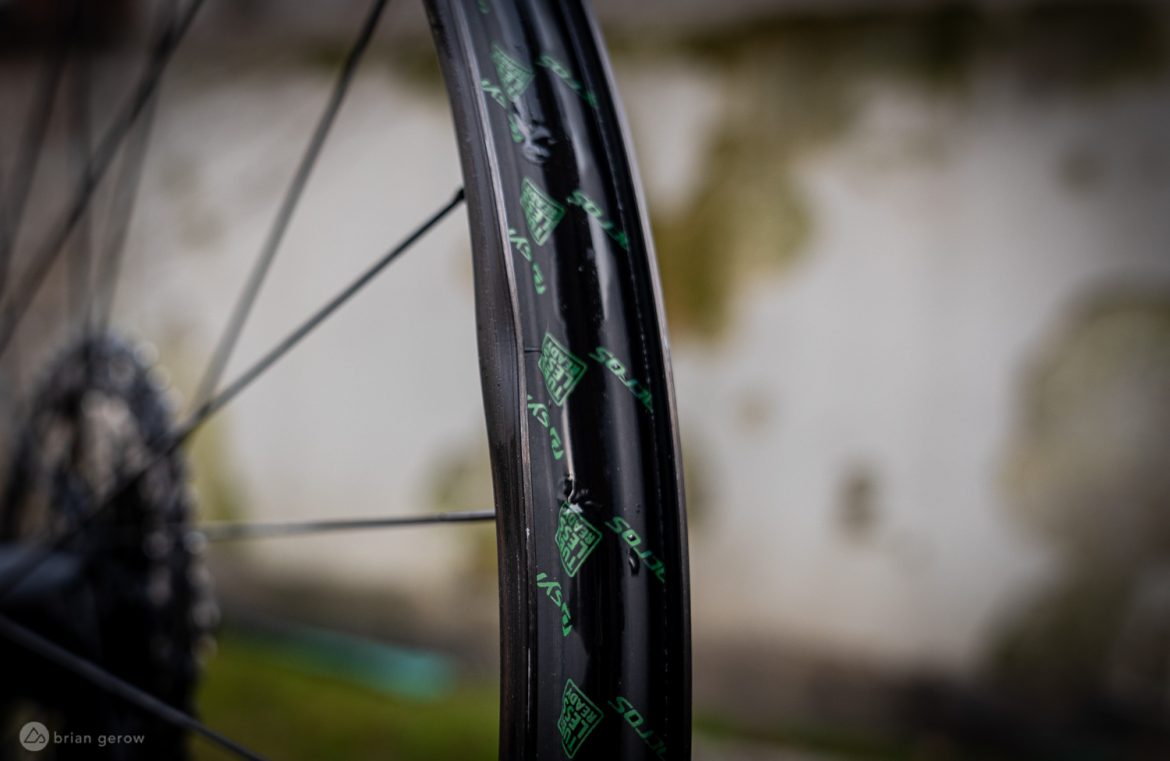
The Quick Question series answers your MTB repair questions. Do you have a quick question about mountain bike repair? 🤔 Email [email protected] and we’ll do our best to answer it!
A mountain bike without scratches and dings is likely one that hasn’t been ridden yet. Playing in the rocks tends to add a lot of character to our gear, and rims are no exception. Whether we neglect to check the tire pressure or are simply riding fast on rough trails, almost everyone eventually bends an aluminum rim. It can even happen with higher pressures and inserts if you’re really pushing the pace, and often the dent makes it difficult to then achieve a solid tubeless seal.
According to Dustin Adams at We Are One Composites, bent rims are one area where carbon fiber rims often triumph over alloy. Carbon can be laid up to provide significant movement during a rim impact, allowing it to compress into an egg shape and spring back, where aluminum will flex to a point, and after that point, it will not return to the original desired shape. A counterargument is that aluminum rims can often be repaired if bent, where a broken carbon rim needs to be replaced in most cases. We’re not here to help you decide between alloy and carbon hoops, but to fix the dented metal.

There’s a good chance that alloy circle can be bent back into a shape that your tire and sealant will accept. In the best case scenario, only the bead-hook bends, and it can easily be pulled back to a tall enough wall to hold the tire and keep on rollin’.
Both the Syncros Revelstoke 1.5 and Crankbrothers Synthesis I9 aluminum wheels I tested last year ended up with dents in the rims after I reviewed them that had to be hammered out. The indentations were sharp enough that they pressed the tire bead out of its channel, preventing a proper tubeless seal. The solution in both cases was found in a few chunks of medium-hardness wood, a pallet, and a hammer. Consider turning off your perfectionist switch for this one; it’s time for a classic good-enough repair.

Find a soft surface to lay the wheel on where the hub can rest without applying much load on the spokes. A small pallet like this one that came attached to a washing machine works well to hold the wheel still without scratching the rim finish. Then, any piece of wood that’s about the size of the dent will do well to reverse the impact from the rock strike without creating any sharp edges inside the rim. Center the stick and smack away until the bead hook becomes fairly straight again. It doesn’t have to be perfect to hold the bead seal, and often bending it back 50% will be sufficient. Then, true the wheel, mount the tire, and enjoy!

If you happen to have a bench vice with a soft clapping jaw, that can also do well to bring the rim back to a straight-enough stance. Try not to clamp too much of the rim, as you can end up bending a larger portion and then chasing the dent around the wheel and eventually needing to replace the rim.
If you simply need to straighten things out so you can ride or race, and don’t care what the finished product looks like, grab the bead hook with a set of plumbing pliers like those pictured below and gently tilt it back in the right direction. I like to wrap the jaws in old jeans so they don’t cut into the alloy and create issues for the tire. Take care not to bend too far, as it’s easy to dent the outer or inner rim profile with the pliers and create new problems. The rim tape may need to be replaced if there are cuts from the impact or pliers.

If you’ve huffed and puffed enough and can’t get the bead hook and tire bead to play together there is another trick to try. Before tubeless rims existed, we would take a tube that’s smaller than the diameter of the wheel, like a 26″ tube, and cut it along the outermost edge all the way around the circle. Then, insert the valve and stretch the splayed tube carcass over the rim like a giant rubber band before installing the tire over the top of the tube. The tube rubber between the tire and rim will take up some space from the dents, typically allowing the tire to seal and be safely ridden.

The pallet can also work to re-round wheels that have been dented inward, in the egg-shape direction. I worked at a shop in Florence, Italy, where we serviced loads of DH race rigs, and I learned this move to save customers a little money and get them back on track. Place the part of the rim that’s bent inward (toward the hub) between two boards. Then place a striking board inside the rim and bang on it until things are round enough to ride. You’ll typically need to tighten the spoke nipples where the bend is unless you are magically able to get the wheel back “in round.” This is definitely not an ideal fix, but it might save your MTB vacation or race day.
What helpful tips do you have for straightening rims that won’t hold a tubeless seal? Please share them with us in the comments below.





















1 Comments
Jun 24, 2021